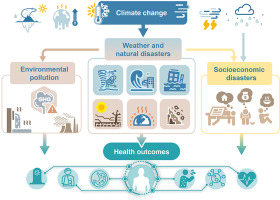
Scientists Connect Humid Heatwaves with Recent Rainfall Trends, Providing Promise for Enhanced Early Warnings
In a revolutionary finding that may transform our approach to tackling hazardous heatwaves, researchers from across the globe have established that the likelihood of extreme humid heat events is significantly affected by recent rainfall trends. This novel understanding, featured in the journal Nature Communications, could lead to the development of more precise early warning systems, particularly for regions vulnerable to climate changes, such as tropical and subtropical areas.
The research was led by an international group of climate specialists from the University of Leeds and the UK Centre for Ecology and Hydrology. By examining twenty years’ worth of weather and climate records, the team identified a crucial connection between daily variations in rainfall and the emergence of perilous humid heat events—heatwaves that, unlike their drier equivalents, present distinct and serious health dangers due to high humidity that inhibits the body’s cooling process through sweating.
A Lethal Combination of Heat and Humidity
Although dry heatwaves pose their own threats, humid heatwaves are especially fatal. Experts employ a measure known as “wet-bulb temperature” to reflect the joint effects of heat and humidity on human health. When the wet-bulb temperature reaches 35°C, the body can no longer regulate temperature through perspiration effectively, rendering even slight outdoor endeavours risky and potentially deadly.
“Humans prevent overheating by sweating. When the humidity is elevated, sweat evaporates inefficiently, causing this cooling mechanism to fail,” stated Professor Cathryn Birch, a co-author of the research.
In a number of subtropical locales, such as certain areas in the Middle East and South Asia, there have already been documented cases of wet-bulb temperatures nearing or surpassing this dangerous level.
New Findings Emphasize the Importance of Rainfall
The researchers discovered that the connection between rainfall and the risk of humid heat differs by region:
– In drier tropical and subtropical areas, like parts of inland India or West Africa during dry seasons, the likelihood of extreme humid heat events increased on or shortly after a rainfall day. This is due to rain saturating parched soil, enhancing surface evaporation, and subsequently raising atmospheric humidity, even as temperatures climb.
– In contrast, in already humid or rainforest-rich regions such as the Amazon and Congo Basin, the most severe humid heat followed days of low rainfall. Less precipitation results in fewer clouds, permitting greater solar radiation to hit the ground and elevating temperatures—creating optimal conditions for humid heat extremes.
“This intricate interplay between rainfall and humid heat indicates that a universal model cannot predict the timing or location of these dangerous occurrences,” clarified Dr. Lawrence Jackson, lead author of the study and Research Fellow at the University of Leeds. “This is where our research delivers transformative insights.”
Implications for Climate Adaptation and Public Health
By utilizing near real-time satellite information regarding rainfall and soil moisture, climate scientists and meteorological organizations can start to create early warning systems custom-designed to identify the conditions that lead to humid heatwaves. In areas where at-risk populations—such as outdoor laborers and individuals without effective cooling means—are already feeling the impact of climate change, these tools could offer prior warnings and assist in preventing heat-related health issues or fatalities.
“Even minor increases in global temperature can trigger disproportionately large escalations in humid heat in tropical regions,” Professor Birch remarked. “As climate change intensifies these dangers, we urgently require not only to reduce greenhouse gas emissions but also to enhance warning systems tailored to the specific dynamics of humid heat.”
Focus Areas for Proactive Measures
The research covered various tropical and subtropical regions—from India’s monsoon zone and the coastal cities of East China to the equatorial rainforests of South America and Africa, along with the scorching, arid coasts of the Middle East. By aggregating satellite data on daily rainfall metrics and utilizing machine learning methods to model risk connections, the team successfully identified regional differences that can now shape local risk assessments and public health approaches.
“This emphasis on daily timeframes is a major advancement toward localized forecasts,” stated Professor John Marsham, co-author and Professor of Atmospheric Science. “The logical next step is to refine predictions to an hourly basis, enabling communities to respond to swiftly emerging threats.”
Urgency of Climate Action and a Call for Engagement
As climate change raises temperatures globally, especially in rapidly growing tropical regions, the findings stress the pressing need for both global mitigation actions and practical adaptation measures.
“This understanding allows officials to better predict when and where a hazardous humid heatwave may emerge,” explained Dr. Jackson. “It’s not solely theoretical—it’s crucial for safeguarding human lives in the most vulnerable and least prepared parts of the world.”
In confronting a swiftly evolving climate, incorporating rainfall-based insights into meteorological predictions and public health systems could serve as a vital shield against one of the most insidious consequences of climate change. This research serves as a reminder to policymakers, scientists, and community members that, while the fight against global warming is ongoing, science continues to provide innovative strategies for managing its repercussions—before